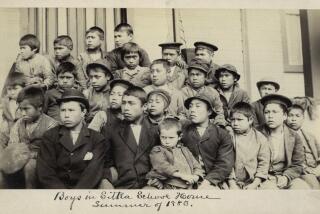‘ROANOAK’ MINISERIES BOWS ON PBS
- Share via
NEW YORK — A chapter in early American history will be seen from the vantage point of the Native American Indian, for a change, in “Roanoak,” a new miniseries made for public television.
The three-hour, three-part drama will be broadcast on PBS’ “American Playhouse” starting tonight (8 p.m. on Channel 50, 9 p.m. on Channels 28 and 15).
The story chronicles the first recorded meeting in the late 16th Century between British explorers-settlers and Native Americans in what is now North Carolina, and the conflicts that ensued between the two diverse cultures before this early settlement mysteriously vanished.
Throughout the series, which is in great part in Native American language with English subtitles, the Native Americans’ impression of the British as benevolent strangers who transform into barbarian invaders is stressed.
“This is an episode of American history that predates our knowledge of our own history and that is rarely dramatized, certainly not from the point of view of Native Americans,” said “American Playhouse” executive producer Lindsay Law said.
Four years in the making, the miniseries cost $3.6 million to produce, according to Law, who said the time and expense were devoted to the project to achieve authenticity and to avoid stereotypes. He cited the same reason for the decision to use the Ojibwe language, a derivative of the Algonquin language spoken at the time by the Roanoak Indians. “It certainly makes more understandable how the two group cultures mis understood each other,” Law said.
Shot on location last year in South Carolina and Virginia under the direction of Jan Egleson, the miniseries attempts to re-create how the Native Americans looked and lived at the time as well as the story of their eventual clash with the British settlers.
Law said the production relied on surviving watercolors by John White, English governor of the Roanoak settlement, who is played in the miniseries by Victor Garber, and on first-hand written accounts from that period that also survive.
Law pointed out that seven contemporary American Indian tribes are represented among “extras” appearing in the miniseries, including the Lumbee tribe of North Carolina, believed to be descendants of the so-called “lost colony” of Roanoak.
And all the professional actors from New York and Los Angeles cast in the principal Native American roles were said to be at least in part Native American, including actor Will Sampson, who achieved prominence with his Oscar-nominated performance as Chief Bromden in the 1975 film version of “One Flew Over the Cuckoo’s Nest.”
Law credited the origin of the ambitious project to James McCarthy, who co-wrote the teleplay (with Dina Harris). McCarthy, the son of actor Kevin McCarthy and a New York-based documentary cameraman as well as writer, said the project initially was developed in 1980 with funds from the National Endowment for the Humanities, and was taken to “American Playhouse” because “we wanted to avoid any compromise” that might have been required for presentation on one of the three major networks. He cited the possibility of “a love story” angle.
“We definitely are making demands on the (TV) audience by making them re-evaluate their thinking about Native Americans and the English settlers,” McCarthy said.
“We intended to tell a good tale about a little-known aspect of American history,” he continued. “But the conflict between the two different cultures also provides a metaphor for the struggle that continues to go on today when technically advanced countries go into Third World countries for so-called development.
“It’s about what happens when people who believe themselves to be superior attempt to ‘benefit’ those they see as inferior.”
More to Read
The complete guide to home viewing
Get Screen Gab for everything about the TV shows and streaming movies everyone’s talking about.
You may occasionally receive promotional content from the Los Angeles Times.






